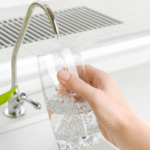Have you tried an alternative cooking method where you use less water yet? So many of you have sent in messages about trying out new techniques. We’re glad that they’re a positive water-saving substitute for you. However, we can’t remove water from cooking entirely – we love pasta too much! So, in this blog, we want to show you how you can reuse cooking water instead. After all, if you can’t reduce, reuse is the next best thing.
Using less water while cooking is one thing but reusing it is just as beneficial. When a pint of tap water goes down the drain, its carbon footprint triples. This means that reusing cooking water is a great way to reduce your environmental impact. Let’s take a look at some of our favourite reuse tips for the foods that are often boiled.
How to reuse cooking water: Pasta
Ever been to an Italian restaurant and wondered why the pasta tastes so good? To the point where you’ve been ripping your hair out trying to recreate it at home. It’s not the fresh pasta, it’s not the duration it’s cooked for, and it isn’t a special concoction of herbs and spices. It’s the water. In many restaurants, the same pasta water will be used throughout the evening. Gaining more rich starchy goodness as the night goes on.
The starchy water created from cooking pasta is great for – you guessed it – cooking even more pasta! But if you’re not too keen on storing your water in the fridge ready to reuse again, here are a few other ways you can reuse it.
- Mix it with your cooking sauces for a thick smooth silky texture
- Leave it to cool slightly, rub it on your hair and leave in for 10 minutes (thank us later for that shine!)
- Washing up! It might seem like dirty water, but the natural starch mineral content acts as a natural detergent.

Reuse cooking water: Rice
We learnt a lot in the Greenredeem activities last week – including how much water we need to make the perfect fluffy rice. But we’re not perfect, and we’re not expecting you to be either! So, if you have some leftover water when cooking rice; here’s how to reuse it.
Treat your sunburn with it. We know, it’s only April, but let’s be honest the British weather is about as predictable as… well truth be told nothing is as unpredictable as British weather. This month alone we’ve had hot belters leaving us sweating and snowstorms – in the same week! Rice water is perfect for treating sunburn and soothing the skin. The next time we inevitably underestimate the British weather and get caught outside without and sunscreen, we’ll be rubbing rice water into our skin for some relief.

Reuse cooking water: Potatoes
Of course, we would suggest reducing your water consumption when it comes to cooking potatoes. After all, we can roast them which means using no water. But we also understand that boiled new baby potatoes are a necessity in some meals. So, here is your next best option.
Have you ever used the expression that you ‘feel like a potato’ – also known as being ‘run down’? Well, ironically you can reuse potato water to help yourself feel better by soaking your feet in it or giving yourself a revitalising facial. Similar to pasta water, potato water is also filled with starch making it perfect for soothing achy feet and bringing a revitalising fresh feel to your face. If you boil your potatoes with skin on be sure to give them a good clean first, and if you peel them, use the peeling to make some tasty crisp snacks while you enjoy your potato-spa activity!

Reusing veggie cooking water
As we spoke about in our recent blog, we think steaming veggies is not only a great way to save water but also locking in taste. We’ve said it once, we’ll say it again, we know that everyone needs options. We can’t all live a perfect eco-friendly lifestyle so when one eco-option doesn’t work out, we want to supply you with the next best thing. For vegetables, here’s how to reuse the water.
If you’ve boiled some broccoli, you know that the colour of the water can change. This doesn’t make it ideal for washing the dishes or cleaning your hair. However, if there’s one thing vegetable water is good for, it’s watering plants. Make sure you allow the water to cool first, but all the nutrients and minerals that vegetables lose when boiling are perfect for watering your plants. You case use the water as soon as it’s cool or refrigerate it for a couple of days until your plants need a drink.

How to store the cooking water
You might be sat thinking “the last thing I want to do after cooking potatoes is soak my feet in the water”. We understand, using the water when it’s still warm isn’t exactly practical, you’re almost always going to still be cooking or eating your dinner. So, here’s how you can store it.
That’s right, you can store your cooking water. It means that if you want to keep the starchy goodness of your pasta water you can pop it in a jar/jug (be sure to cover it) and reuse it for the next time you make some pasta. If you only pamper yourself on a Sunday and you’ve made rice on a Thursday, you can pop the water in the fridge and then heat it up again to use for your facial. You never need to reuse your water straight away. Simply seal it in a pot and pop it in the fridge until you need to use it.
So, there you have it, 4 different ways to reuse cooking water around your home. Some of these ideas are interchangeable, for example, you can also use unsalted pasta water to water your indoor plants. But it’s important to recognise that cooking water can be reused in a multitude of ways. Pouring these nutrient-rich waters down the drain just doesn’t make sense now we know their value. What water will you reuse this week?









2 Responses
Why no points?
Hi Chris, points are only available for the most recent blog. Each week a new blog is posted where you can claim your points 🙂